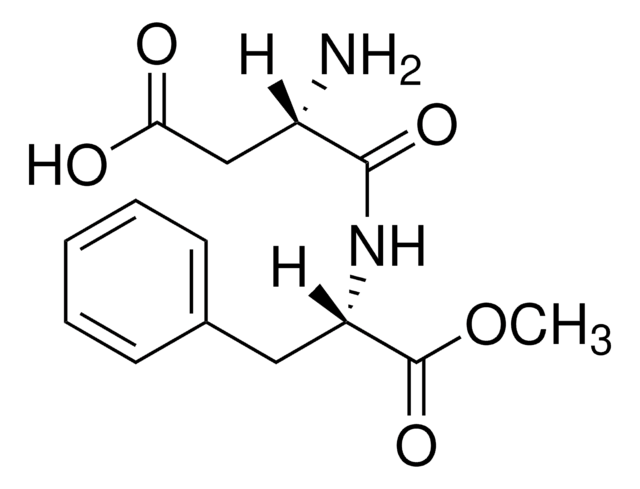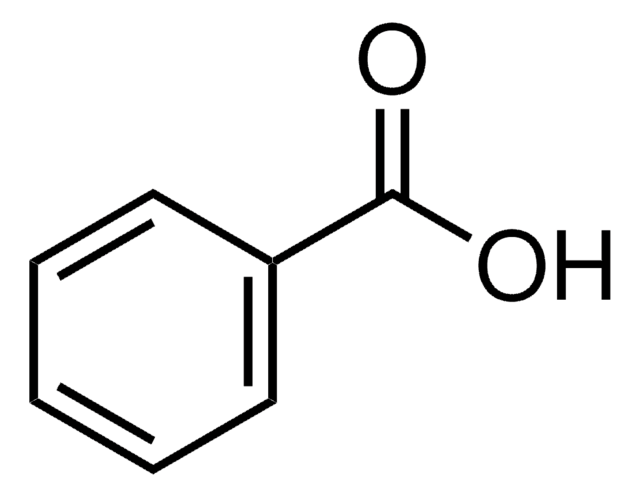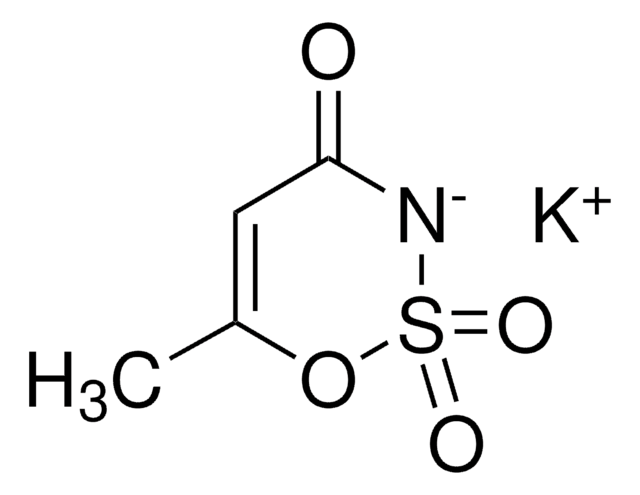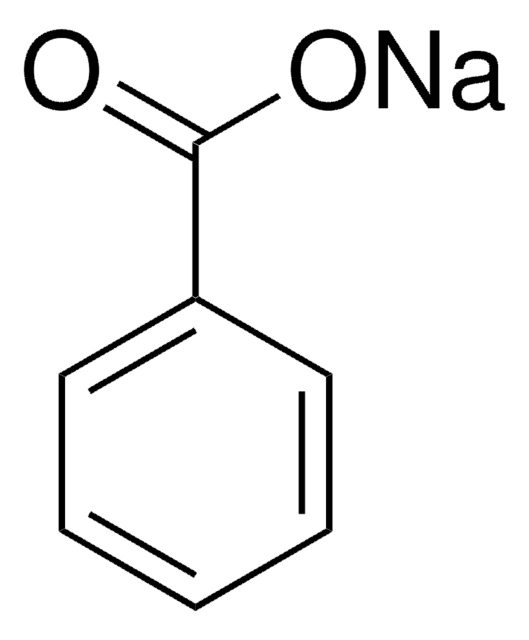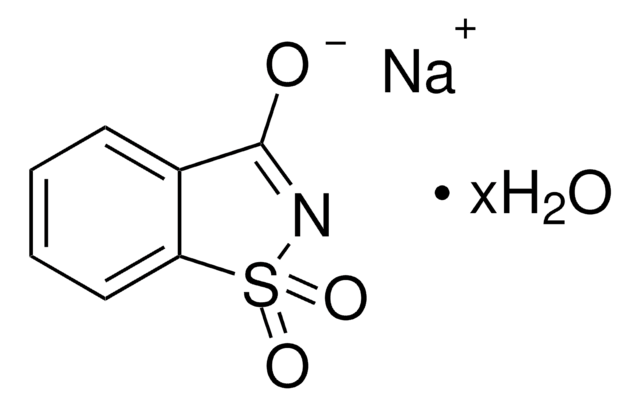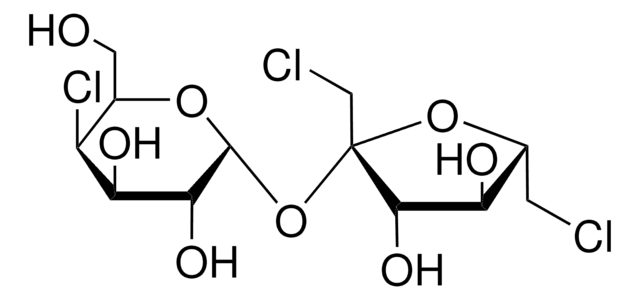PHR1341
Saccharin
Pharmaceutical Secondary Standard; Certified Reference Material
동의어(들):
Saccharin, 2,3-Dihydroxy-1,2-benzisothiazol-3-one-1,1-dioxide, 2-Sulfobenzoic acid imide, o-Benzoic sulfimide
로그인조직 및 계약 가격 보기
모든 사진(1)
About This Item
실험식(Hill 표기법):
C7H5NO3S
CAS Number:
Molecular Weight:
183.18
Beilstein:
6888
EC Number:
MDL number:
UNSPSC 코드:
41116107
PubChem Substance ID:
NACRES:
NA.24
추천 제품
Grade
certified reference material
pharmaceutical secondary standard
Quality Level
Agency
traceable to Ph. Eur. S0040000
traceable to USP 1607007
API family
saccharin
CofA
current certificate can be downloaded
기술
HPLC: suitable
gas chromatography (GC): suitable
mp
226-229 °C (lit.)
응용 분야
pharmaceutical (small molecule)
형식
neat
저장 온도
2-30°C
SMILES string
O=C1NS(=O)(=O)c2ccccc12
InChI
1S/C7H5NO3S/c9-7-5-3-1-2-4-6(5)12(10,11)8-7/h1-4H,(H,8,9)
InChI key
CVHZOJJKTDOEJC-UHFFFAOYSA-N
유사한 제품을 찾으십니까? 방문 제품 비교 안내
일반 설명
Saccharin is a well-known non-carbohydrate, sulfonyl amide artificial sweetener and is generally used in the form of its calcium or sodium salt. It possesses a sweetening power of about 550 times more than that of saccharose. On losing the acidic imino hydrogen, it forms the corresponding nitro anion, which exhibits interesting coordination chemistry. It offers a bitter and metallic aftertaste which limits its use as an artificial sweetening agent.
Certified pharmaceutical secondary standards for application in quality control provide pharma laboratories and manufacturers with a convenient and cost-effective alternative to in-house working standards.
Certified pharmaceutical secondary standards for application in quality control provide pharma laboratories and manufacturers with a convenient and cost-effective alternative to in-house working standards.
애플리케이션
Saccharin can be used as a pharmaceutical reference standard for the determination of the analyte in pharmaceutical formulations by chromatographic and spectrophotometric techniques.
These Secondary Standards are qualified as Certified Reference Materials. These are suitable for use in several analytical applications including but not limited to pharma release testing, pharma method development for qualitative and quantitative analyses, food and beverage quality control testing, and other calibration requirements.
생화학적/생리학적 작용
A sweet tastant for mammals. A glycerol taste receptor binding site specific for glucose has been proposed in drosophila.
분석 메모
These secondary standards offer multi-traceability to the USP, EP (PhEur) and BP primary standards, where they are available.
기타 정보
This Certified Reference Material (CRM) is produced and certified in accordance with ISO 17034 and ISO/IEC 17025. All information regarding the use of this CRM can be found on the certificate of analysis.
각주
To see an example of a Certificate of Analysis for this material enter LRAC3561 in the slot below. This is an example certificate only and may not be the lot that you receive.
추천 제품
Find a digital Reference Material for this product available on our online platform ChemisTwin® for NMR. You can use this digital equivalent on ChemisTwin® for your sample identity confirmation and compound quantification (with digital external standard). An NMR spectrum of this substance can be viewed and an online comparison against your sample can be performed with a few mouseclicks. Learn more here and start your free trial.
관련 제품
제품 번호
설명
가격
Storage Class Code
11 - Combustible Solids
WGK
WGK 2
Flash Point (°F)
Not applicable
Flash Point (°C)
Not applicable
가장 최신 버전 중 하나를 선택하세요:
이미 열람한 고객
Metal complexes of saccharin
Baran EJ and Yilmaz VT
Coordination Chemistry Reviews, 250(15-16), 1980-1999 (2006)
Bitter taste receptors for saccharin and acesulfame K
Kuhn C, et al.
The Journal of Neuroscience, 24(45), 10260-10265 (2004)
HPLC analysis of aspartame and saccharin in pharmaceutical and dietary formulations.
Di Pietra AM, et al.
Chromatographia, 30(3-4), 215-219 (1990)
Saccharin analysis in pharmaceutical and cosmetic preparations by derivative ultraviolet spectrophotometry
Vianna-Soares CD and Martins JLS
Brazilian Journal of Pharmaceutical Sciences , 38(4), 471-478 (2002)
M D Reuber
Environmental health perspectives, 25, 173-200 (1978-08-01)
Saccharin is carcinogenic for the urinary bladder in rats and mice, and most likely is carcinogenic in human beings. The neoplasms of the urinary bladder are malignant and invade and metastasize. Male rats are more susceptible to urinary bladder carcinogenesis
자사의 과학자팀은 생명 과학, 재료 과학, 화학 합성, 크로마토그래피, 분석 및 기타 많은 영역을 포함한 모든 과학 분야에 경험이 있습니다..
고객지원팀으로 연락바랍니다.